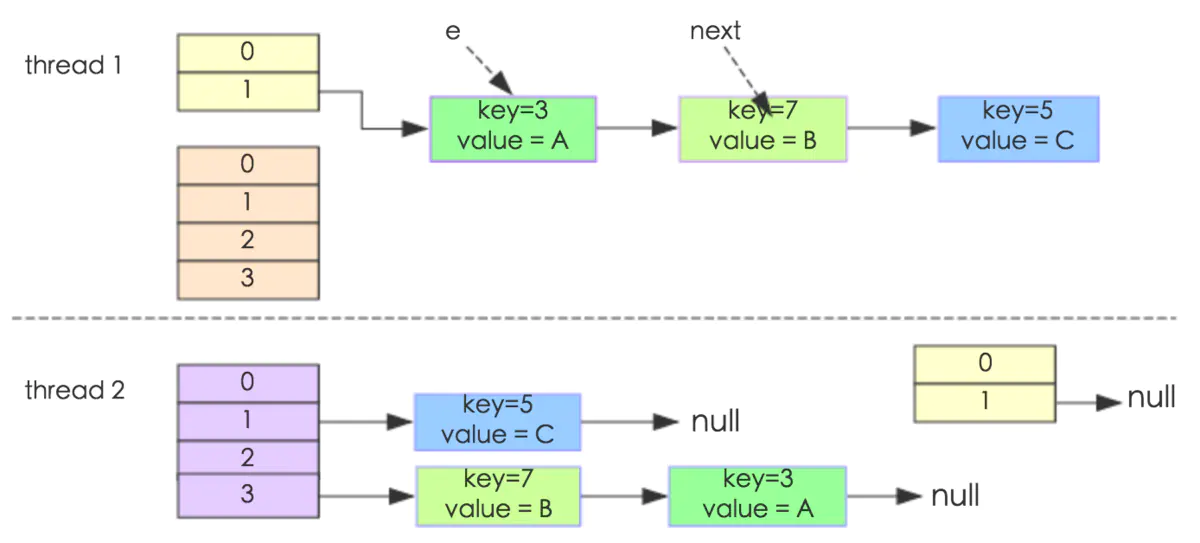HashMap
简单HashMap的实现:https://juejin.cn/post/6844903920947429390#comment
线程不安全
Java7
void transfer(Entry[] newTable, boolean rehash) {int newCapacity = newTable.length;for (Entry<K,V> e : table) {while(null != e) {Entry<K,V> next = e.next;if (rehash) {e.hash = null == e.key ? 0 : hash(e.key);}int i = indexFor(e.hash, newCapacity);e.next = newTable[i];newTable[i] = e;e = next;}}}

我们假设有两个线程同时需要执行resize操作,我们原来的桶数量为2,记录数为3,需要resize桶到4,原来的记录分别为:[3,A],[7,B],[5,C],在原来的map里面,我们发现这三个entry都落到了第二个桶里面。
假设线程thread1执行到了transfer方法的Entry next = e.next这一句,然后时间片用完了,此时的e = [3,A], next = [7,B]。线程thread2被调度执行并且顺利完成了resize操作,需要注意的是,此时的[7,B]的next为[3,A]。此时线程thread1重新被调度运行,此时的thread1持有的引用是已经被thread2 resize之后的结果。线程thread1首先将[3,A]迁移到新的数组上,然后再处理[7,B],而[7,B]被链接到了[3,A]的后面,处理完[7,B]之后,就需要处理[7,B]的next了啊,而通过thread2的resize之后,[7,B]的next变为了[3,A],此时,[3,A]和[7,B]形成了环形链表,在get的时候,如果get的key的桶索引和[3,A]和[7,B]一样,那么就会陷入死循环。
如果在取链表的时候从头开始取(现在是从尾部开始取)的话,则可以保证节点之间的顺序,那样就不存在这样的问题了。
作者:一字马胡
链接:https://www.jianshu.com/p/e2f75c8cce01
来源:简书
著作权归作者所有。商业转载请联系作者获得授权,非商业转载请注明出处。
Java8
final V putVal(int hash, K key, V value, boolean onlyIfAbsent,boolean evict) {Node<K,V>[] tab; Node<K,V> p; int n, i;if ((tab = table) == null || (n = tab.length) == 0)n = (tab = resize()).length;if ((p = tab[i = (n - 1) & hash]) == null) // 如果没有hash碰撞则直接插入元素tab[i] = newNode(hash, key, value, null);else {Node<K,V> e; K k;if (p.hash == hash &&((k = p.key) == key || (key != null && key.equals(k)))) // 第一个节点就是e = p;else if (p instanceof TreeNode)e = ((TreeNode<K,V>)p).putTreeVal(this, tab, hash, key, value);else { // 链表for (int binCount = 0; ; ++binCount) {if ((e = p.next) == null) {p.next = newNode(hash, key, value, null);if (binCount >= TREEIFY_THRESHOLD - 1) // -1 for 1sttreeifyBin(tab, hash);break;}if (e.hash == hash &&((k = e.key) == key || (key != null && key.equals(k))))break;p = e;}}if (e != null) { // existing mapping for keyV oldValue = e.value;if (!onlyIfAbsent || oldValue == null)e.value = value;afterNodeAccess(e);return oldValue;}}++modCount;if (++size > threshold)resize();afterNodeInsertion(evict);return null;}
这是jdk1.8中HashMap中put操作的主函数, 注意第6行代码,如果没有hash碰撞则会直接插入元素。如果线程A和线程B同时进行put操作,刚好这两条不同的数据hash值一样,并且该位置数据为null,所以这线程A、B都会进入第6行代码中。假设一种情况,线程A进入后还未进行数据插入时挂起,而线程B正常执行,从而正常插入数据,然后线程A获取CPU时间片,此时线程A不用再进行hash判断了,问题出现:线程A会把线程B插入的数据给覆盖,发生线程不安全。
Java8源码分析
初始化
- 设置的容量不能小于0
- 不能大于最大值
- 负载因子不能小于等于0
- 设置负载因子
- 设置门槛作为下次初始化的长度,在构造方法中不初始化数组
public HashMap(int initialCapacity, float loadFactor) {if (initialCapacity < 0)throw new IllegalArgumentException("Illegal initial capacity: " +initialCapacity);if (initialCapacity > MAXIMUM_CAPACITY)initialCapacity = MAXIMUM_CAPACITY;if (loadFactor <= 0 || Float.isNaN(loadFactor))throw new IllegalArgumentException("Illegal load factor: " +loadFactor);this.loadFactor = loadFactor;this.threshold = tableSizeFor(initialCapacity);}
Put
```java public V put(K key, V value) { return putVal(hash(key), key, value, false, true); }
final V putVal(int hash, K key, V value, boolean onlyIfAbsent,
boolean evict) {
Node
1. 数组如果为空,resize初始化数组1. 如果对应的数组位置上是空,则在这个地方添加节点1. 如果这个位置的头结点就是参数中的key,记录这个节点为e1. 否则如果这个节点是树节点,进行树节点的遍历1. 否则遍历这个列表1. 如果已经查找到列表末尾都没有这个key,在列表后面添加节点,并判断是否到达树化的临界点1. 如果有这个节点了,记录这个节点为e6. 如果e!=null(说明节点已经存在),进行覆盖,返回旧值6. 此时说明是添加节点,size++,判断是不是需要扩容6. 返回null<a name="EEN1c"></a>## resize```javafinal Node<K,V>[] resize() {Node<K,V>[] oldTab = table;int oldCap = (oldTab == null) ? 0 : oldTab.length;int oldThr = threshold;int newCap, newThr = 0;if (oldCap > 0) {if (oldCap >= MAXIMUM_CAPACITY) {threshold = Integer.MAX_VALUE;return oldTab;}else if ((newCap = oldCap << 1) < MAXIMUM_CAPACITY &&oldCap >= DEFAULT_INITIAL_CAPACITY)newThr = oldThr << 1; // double threshold}else if (oldThr > 0) // initial capacity was placed in thresholdnewCap = oldThr;else { // zero initial threshold signifies using defaultsnewCap = DEFAULT_INITIAL_CAPACITY;newThr = (int)(DEFAULT_LOAD_FACTOR * DEFAULT_INITIAL_CAPACITY);}if (newThr == 0) {float ft = (float)newCap * loadFactor;newThr = (newCap < MAXIMUM_CAPACITY && ft < (float)MAXIMUM_CAPACITY ?(int)ft : Integer.MAX_VALUE);}threshold = newThr;@SuppressWarnings({"rawtypes","unchecked"})Node<K,V>[] newTab = (Node<K,V>[])new Node[newCap];table = newTab;if (oldTab != null) {for (int j = 0; j < oldCap; ++j) {Node<K,V> e;if ((e = oldTab[j]) != null) {oldTab[j] = null;if (e.next == null)newTab[e.hash & (newCap - 1)] = e;else if (e instanceof TreeNode)((TreeNode<K,V>)e).split(this, newTab, j, oldCap);else { // preserve orderNode<K,V> loHead = null, loTail = null;Node<K,V> hiHead = null, hiTail = null;Node<K,V> next;do {next = e.next;if ((e.hash & oldCap) == 0) {if (loTail == null)loHead = e;elseloTail.next = e;loTail = e;}else {if (hiTail == null)hiHead = e;elsehiTail.next = e;hiTail = e;}} while ((e = next) != null);if (loTail != null) {loTail.next = null;newTab[j] = loHead;}if (hiTail != null) {hiTail.next = null;newTab[j + oldCap] = hiHead;}}}}}return newTab;}
分成两部分
第一部分:扩容操作
- 如果旧的容量>0
- 判断旧容量是不是大于最大容量,如果大于,返回
- 如果不大于,容量加倍
- 如果旧的容量=0
- 如果threshold>0,那么在构造函数里面设置了初试容量(最近的2^n)
- 否则就按默认值16进行初始化
- 按新的容量申请新数组
第二部分:更新位置
- 从0开始遍历旧的数组
- 如果这个位置不为空
- 并且只有一个节点,那么直接放入新数组的
hash&(newCap-1) - 如果是树节点
- 遍历链表
- 如果hash&oldCapacity=0,放入一个链表
- 如果hash&oldCapacity=1,放入一个链表
- 遍历完链表,将两个链表分别放入新链表的当前位置和当前位置+oldCapacity
- 返回新链表
- 并且只有一个节点,那么直接放入新数组的
get
public V get(Object key) {Node<K,V> e;return (e = getNode(hash(key), key)) == null ? null : e.value;}final Node<K,V> getNode(int hash, Object key) {Node<K,V>[] tab; Node<K,V> first, e; int n; K k;if ((tab = table) != null && (n = tab.length) > 0 &&(first = tab[(n - 1) & hash]) != null) {if (first.hash == hash && // always check first node((k = first.key) == key || (key != null && key.equals(k))))return first;if ((e = first.next) != null) {if (first instanceof TreeNode)return ((TreeNode<K,V>)first).getTreeNode(hash, key);do {if (e.hash == hash &&((k = e.key) == key || (key != null && key.equals(k))))return e;} while ((e = e.next) != null);}}return null;}
- 如果链表为空,返回null
- 根据
hash & (capacity-1)得到所属的数组位置 - 如果该位置的第一个节点就是要查找的key,返回
- 如果头结点的下一个不是空
- 是树结点,树结点的查找
- 链表的遍历,遍历到就返回
- 返回空

